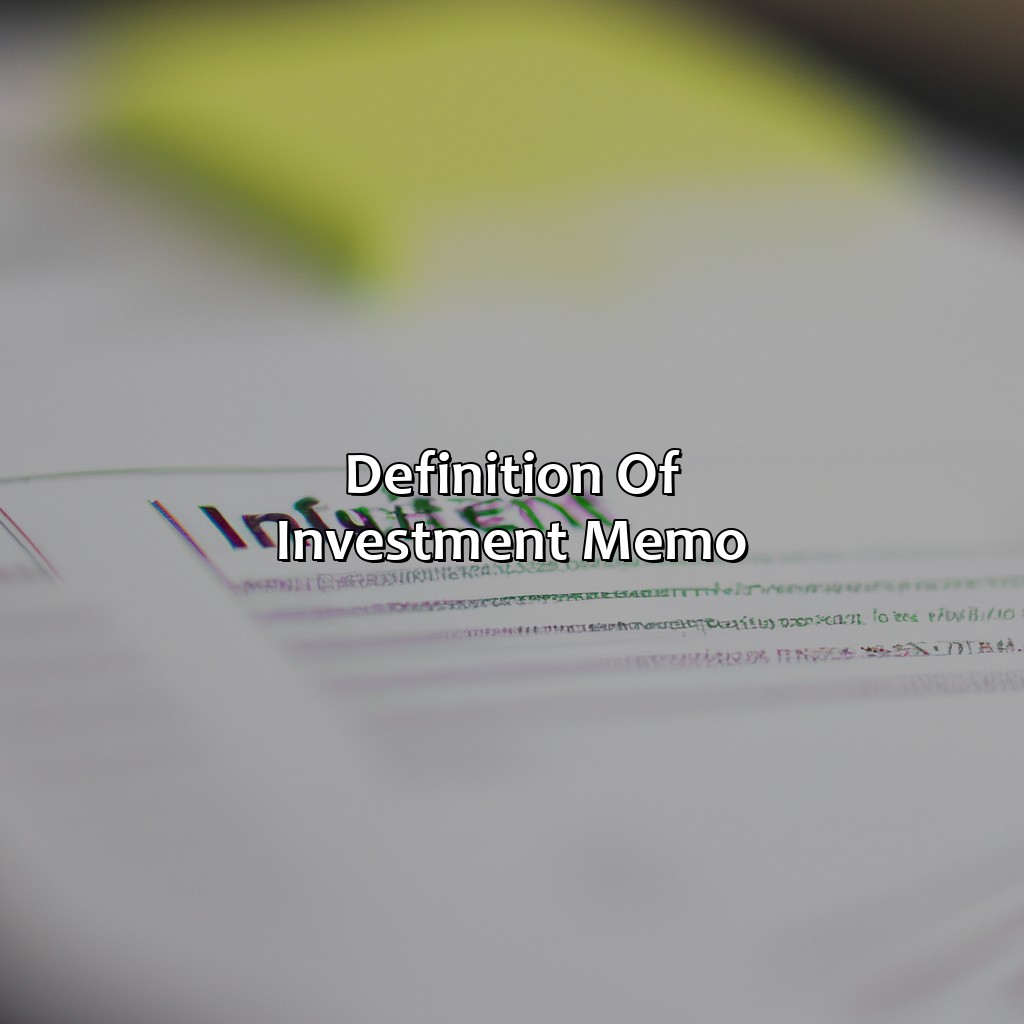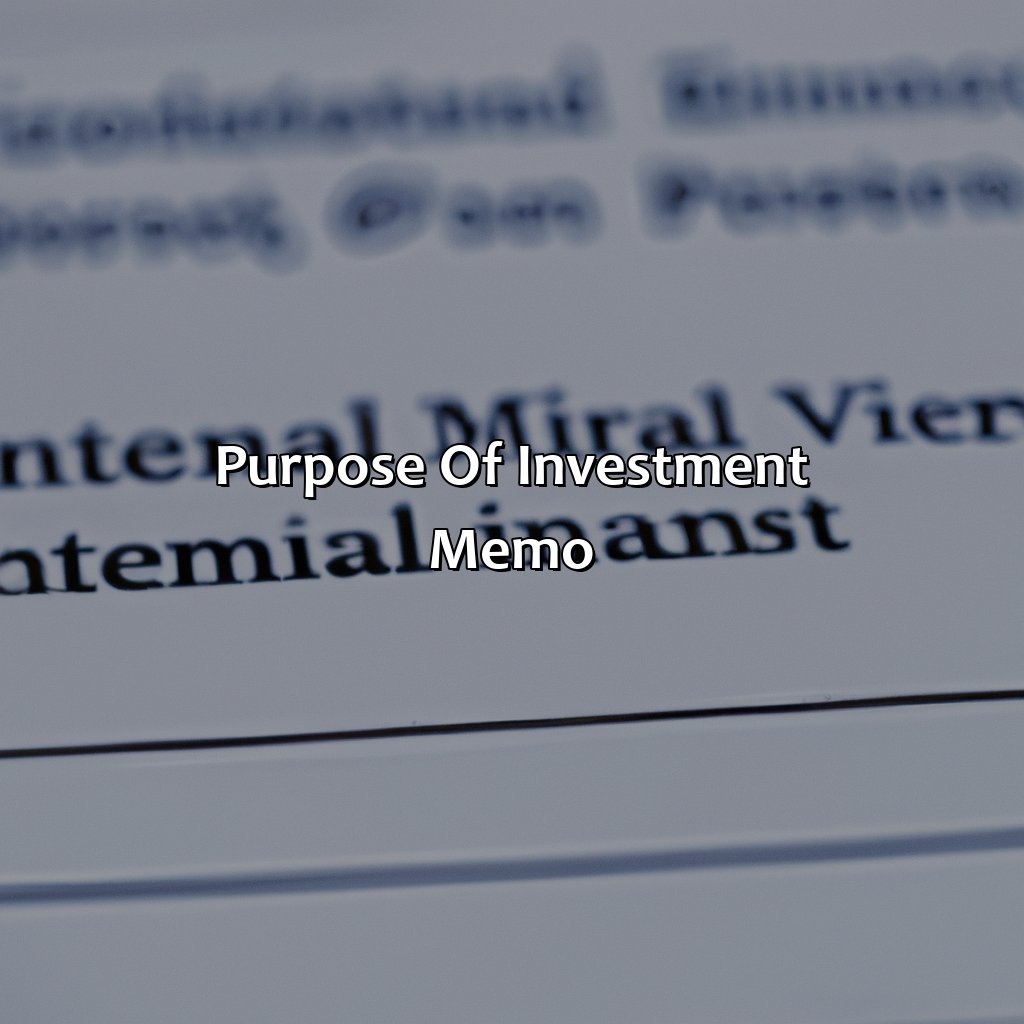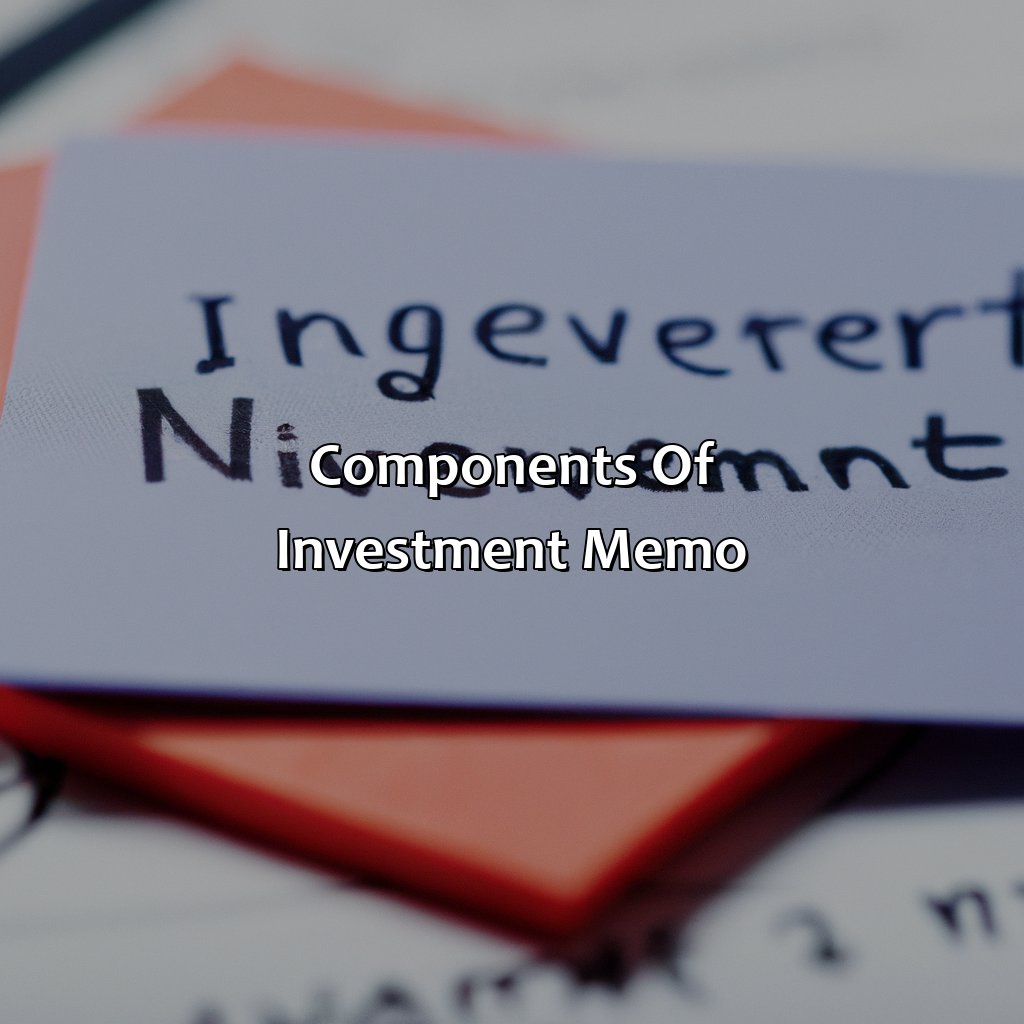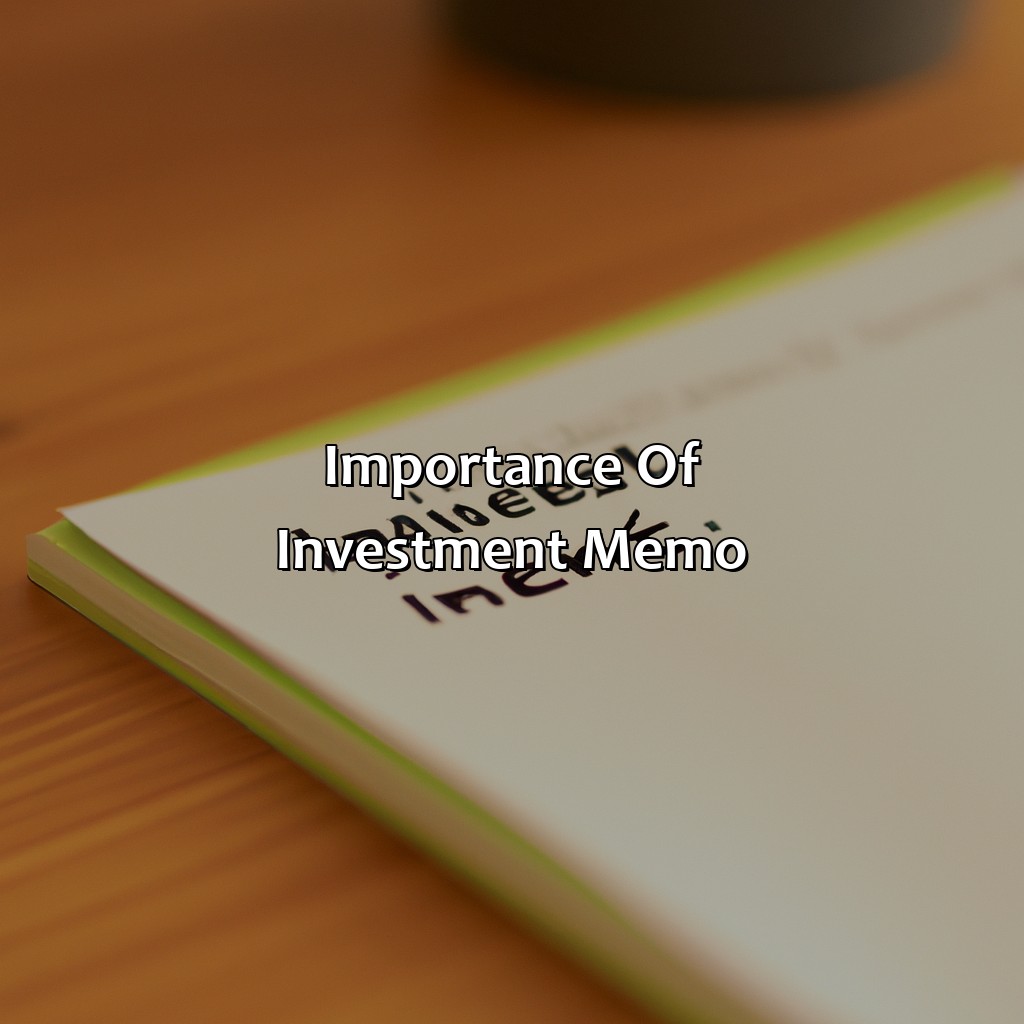What Is An Investment Memo?
Key Takeaway:
- An investment memo is a document that outlines a potential investment opportunity for investors and serves as a due diligence tool for making informed investment decisions.
- The purpose of an investment memo is to provide a comprehensive analysis of the investment opportunity, including its strengths, weaknesses, risks, and financial projections, as well as an investment thesis explaining why the investment is worth pursuing.
- The components of an investment memo include an executive summary, investment thesis, business overview, market analysis, financial projections, and investment risks, each providing pertinent information for investors to evaluate the opportunity.
- The importance of an investment memo lies in its ability to provide a standardized format for evaluating potential investment opportunities, allowing investors to compare and contrast opportunities and make informed investment decisions.
Are you looking for a guide to understand the importance of Investment Memos? Learn how it helps you assess and analyze a potential investment opportunity and make an informed decision. You can maximize your returns by preparing a personalized Investment Memo!
Definition of Investment Memo
Investment memo is a formal document that outlines the potential risks and returns of a financial opportunity. It includes comprehensive details about the investment, such as market size, competition, business models, financial projections, management, and exit strategies. The primary aim of an investment memo is to provide an overview of the investment opportunity to prospective investors. By leveraging this document, investors can make informed decisions about whether to invest in the opportunity or not.
Investment memos provide a detailed and nuanced understanding of the financial opportunity. They offer a comprehensive analysis of the investment risk and return, highlighting potential pitfalls and opportunities for growth. In addition, investment memos offer insights into the management team’s experience and qualifications, as well as the company’s competitive environment. Crucially, investment memos are also used to communicate the exit strategy to investors.
Investment memos play an essential role in the investment process. They serve as a vital tool for prospective investors to evaluate the potential risks and returns of a financial opportunity. Without a well-crafted investment memo, investors would lack the necessary information to make informed decisions about investing. According to a report by Crunchbase News, over 50% of investors reject pitches based on the initial investment deck. Hence, it is crucial to prepare an investment memo that presents the company’s vision, potential, financials, and viability comprehensively.
According to a report by Forbes, over 90% of startups fail, often due to a lack of investor capital. Hence, creating a compelling investment memo is crucial for the survival and success of a startup.

Image credits: retiregenz.com by David Arnold
Purpose of Investment Memo
An Investment Memo serves as a formal document that outlines the purpose, merits, and risks of a potential investment opportunity. It helps investors make informed decisions and acts as a blueprint for strategic planning. By providing comprehensive analysis, financial projections, and market research, the memo enables investors to determine whether the investment is viable and aligns with their goals. It also serves as a reference point for stakeholders to evaluate performance and measure success. Overall, Investment Memo serves as a vital tool for both investors and entrepreneurs to navigate the dynamic world of business opportunities. Such a document constitutes essential parts of venture capital deals and private equity investments.
Investment memo enables potential investors to measure the market size, review company performance, study economic trends, and analyze future growth potential. Additionally, an investment memo outlines the unique selling proposition, company’s management team, existing competition, and other critical factors. It is a collaborative effort between entrepreneurs and investors to evaluate the potential for success, funding needs, and financial returns.
Investment memo has gained tremendous importance in the current era due to the increasing competition and rapidly changing business environment. A well-constructed investment memo offers transparency, credibility, and confidence to all stakeholders involved in the investment decision-making process. Therefore, it is necessary to focus on providing accurate information, financial projections, and complete market insights while preparing the memo.
Several investment memos have played a significant role in shaping the business world, such as the investment memo that convinced Peter Thiel to invest in Facebook in 2004. The memo detailed the potential for social networking and projected future revenue streams. The success of Facebook speaks for the importance of an investment memo and its ability to transform business ideas into successful ventures.

Image credits: retiregenz.com by Yuval Woodhock
Components of Investment Memo
Ensure your investment memo is comprehensive and of value! Focus on six main sections:
- Executive Summary
- Investment Thesis
- Business Overview
- Market Analysis
- Financial Projections
- Investment Risks
Each sub-section has its role in producing a convincing memo which will grab potential investors’ attention.

Image credits: retiregenz.com by Joel Jones
Executive Summary
An Overview of Investment Memo
Investment Memo is a brief yet comprehensive document that offers insights into the investment opportunity, including company details, market analysis, and financial projections. The executive summary is the opening segment of this memorandum, providing a brief description of the investment opportunity’s key aspects.
Key Aspects Covered in an Executive Summary
The executive summary of an investment memo covers critical components like business overview, target market identification, SWOT analysis, competition matrix, financial forecasts, expected ROI (Return on investment) and exit strategies. It should contain sufficient information to attract an investor’s attention and make them desire to learn more about the proposal.
Exploring Unique Details about Investment Memo
Several components make up an effective investment memorandum. These include industry analysis, corporate governance structure, operational plan and budgeting, marketing strategies which are explained elaborately for potential investors looking to fund upcoming projects.
A True-History Example about Investment Memo
In 1998, Steve Jobs presented an Investment Memo for Apple Inc designed to target individual investors interested in taking part in the emerging technological surge. The memo identified several areas within the technology industry as promising ventures and specified how Apple was well-placed to capitalize on these trends – paving way for massive investor interest that led to exponential growth and revenue generations for Apple Inc.
Time to put on your thinking caps, folks, because we’re about to dive deep into the investment thesis – where all the real magic happens.
Investment Thesis
An investment thesis is a focused idea that serves as the foundation for an investment decision. It outlines the reasons why an investment has the potential to be profitable. The thesis should be backed by data and analysis, and take into account market trends, competition, and other relevant factors.
A well-crafted investment thesis helps investors make informed decisions based on a clear understanding of the potential risks and rewards of a particular investment opportunity. It should address key questions such as: What makes this investment unique? How does it fit into the larger market landscape? What are the potential pitfalls?
While an investment thesis is important, it is just one component of a comprehensive investment memo. Other components might include industry research, financial projections, and due diligence documentation.
Investors must conduct thorough research before making any investment decisions; however, even with research in hand, investing involves risk. As Warren Buffett once famously said, “Risk comes from not knowing what you’re doing.” (Source: Forbes)
Get ready for the financial equivalent of a (not so) thrilling novel: the business overview.
Business Overview
Business introduction in an investment memo outlines a company’s primary objectives, achievements, and its competitive outlook. It identifies factors that could impact a company’s profitability, future growth plans, and market share. By providing this information in the business overview section, investors can gain an overall understanding of the company’s operations and potential.
Furthermore, the business overview outlines the company’s core competencies and existing market position. This section is critical as it acts as a foundation for investors to evaluate whether to invest in the company or not. By analyzing key metrics such as revenue growth rate, employee base, and customer retention trends along with analyzing potential challenges due to industry shifts -investors can make informed decisions when considering investment.
Investors should also look out for key indicators which give valuable insights into a company’s leadership team vision, operational efficiencies, and scalability of business model. Key industry partnerships that are invaluable towards long-term success should also be highlighted.
Pro Tip: The Business Overview must start by drawing the reader in with a brief summary that highlights what makes this particular opportunity unique before diving deep into the specifics related to ROI-generation strategies. You can’t predict the future, but with market analysis, you can pretend you can.
Market Analysis
Market Research and Analysis is a crucial step in creating an Investment Memo. It provides valuable insights into the industry trends, competition and customer demand. By analyzing market size, segmentation, growth prospects, and the regulatory environment, investors can make informed decisions about their investment. Additionally, examining macroeconomic factors that can affect the industry can provide further insights.
As part of Market Research and Analysis, it is essential to examine competitors’ products and services. Identifying their strengths and weaknesses can help determine how a proposed investment will fare in the market. Analyzing customer behavior such as preferences, needs, and buying patterns is equally important. This information helps investors create a targeted marketing strategy unique for their product or service.
One crucial aspect of Market Research that must not be overlooked is evaluating external factors that may affect the industry. These factors include political policies, changes in technology, natural disasters or pandemics which could cause unexpected disruption on profitability or consumer outlook.
Financial projections are like a crystal ball, but instead of seeing the future, you’re just staring at a bunch of numbers and hoping for the best.
Financial Projections
The Financial Projections section should provide detailed estimates for revenue, expenses and capital expenditures. The assumptions behind these projections must be discussed in detail. An investor needs to see how these numbers were derived.
Investors are looking for realistic but optimistic projections that show a path to profitability and positive cash flow. They will compare these forecasts to historical trends and industry data to determine whether the projections are achievable.
According to Harvard Business School, “Inaccurate or incomplete financial information is the most common reason investors reject proposals.” Hence, it’s important that entrepreneurs take extra care while creating their financial projections.
Taking risks in investing is like playing Jenga with your money, it’s all fun and games until the tower comes crashing down.
Investment Risks
Investment risks are a complex sequence of potential hazards that can obstruct an investor’s financial growth and lead to monetary losses. These potential hazards encompass diverse aspects, including market fluctuations, legal matters, geopolitical risks, and currency volatility. Different industries and markets carry different levels of risk, making it essential for an investor to comprehensively evaluate the related risks before making any investment decision.
An in-depth examination of the investment risks provides great insights into the potential pitfalls that can impact an investor’s financial returns. It is critical to meticulously analyze each hazard and identify its probability of occurrence. Careful consideration should also be given to the severity of each potential risk and whether it can be mitigated through suitable strategies.
Investors must also keep themselves updated on unique details that can play a crucial role in determining their investment outcomes. Factors such as regulatory changes, technological advancements, competitive pressures, and social or environmental issues could contribute towards previously unanticipated investment threats.
Pro Tip: A successful investor considers both qualitative and quantitative factors when evaluating investment risks. It involves assessing the reliability of historical data by conducting due diligence on business models, management effectiveness and engaging independent advisors where necessary.
An investment memo is like a map, without it you’ll be lost in the wilderness of financial decisions.
Importance of Investment Memo
When considering an investment opportunity, an investment memo is a vital tool for informing potential investors. This document outlines important details about the investment, including financial projections and market analysis. Its significance lies in its ability to provide clear and concise information that investors can use to make informed decisions regarding the opportunity. Through an investment memo, investors can obtain valuable insights into the potential risks and returns associated with the investment. Without this information, investors may lack the confidence to commit their resources to the opportunity.
To put it simply, an investment memo is an essential document that plays a crucial role in influencing investment decisions. It enables investors to have a detailed understanding of the investment and its prospects. Through this document, investors can scrutinize the investment opportunity and assess its viability with accuracy. By providing a detailed analysis of the investment, the memo can help investors identify potential threats and opportunities. Overall, an investment memo reduces uncertainty and provides critical information required for making reliable choices.
A significant benefit of an investment memo is that it provides detailed insights into the investment that may not be readily apparent from other sources. It is the product of meticulous research and thorough analysis, which provides a wealth of information that investors can use to evaluate the potential prospects of the opportunity. By minimizing uncertainty, an investment memo instills confidence in the investment, providing vital support needed to secure investment commitments.
Pro Tip: Ensure the investment memo is structured in a way that is easy to read and understand. Use an informative and formal tone, and make sure it is free from any ambiguity or confusion, as this may create confusion, causing investors to lose interest in the opportunity.

Image credits: retiregenz.com by James Duncun
Five Facts About What Is An Investment Memo:
An investment memo is a document that provides details about a potential investment opportunity. (Source: The Balance)
Investment memos typically outline the risks, benefits, and financial projections of the investment. (Source: Investopedia)
The purpose of an investment memo is to help potential investors make informed decisions about whether to invest in a particular opportunity. (Source: Angel Investing)
Investment memos are often used by venture capitalists, angel investors, and private equity firms. (Source: Harvard Business Review)
A well-crafted investment memo should provide a compelling case for why an investor should invest in the opportunity. (Source: Entrepreneur)
FAQs about What Is An Investment Memo?
What is an investment memo?
An investment memo is a document that provides detailed information about a potential investment opportunity. It is a summary of the opportunity, including key details such as the company’s background, financial information, growth potential, and risks.
Why do investors create investment memos?
Investors create investment memos as a way to evaluate the potential return on investment of a particular opportunity. It helps them make an informed decision about whether or not to invest their money, and if so, how much to invest and what terms to negotiate.
What should be included in an investment memo?
An investment memo should include information about the company’s background, market size, competition, financial performance, growth potential, and risks. It may also include information about the management team, the investment structure, and the potential returns on investment.
Who typically creates an investment memo?
An investment memo is typically created by the investor or investment team that is considering the opportunity. However, in some cases, the company seeking investment may be required to provide a memo for potential investors to review.
How is an investment memo used in the investment process?
Investment memos are typically used as a way to evaluate and compare investment opportunities. Potential investors will review the memo to understand the details of the investment opportunity and determine if it is a good fit for their investment portfolio.
What are the key benefits of using an investment memo?
The key benefits of using an investment memo include the ability to evaluate and compare investment opportunities, make informed investment decisions, and negotiate favorable terms. Additionally, investment memos provide a clear summary of the potential risks and returns associated with an investment opportunity.
 Checkout this IRS Loophole
Checkout this IRS Loophole 
